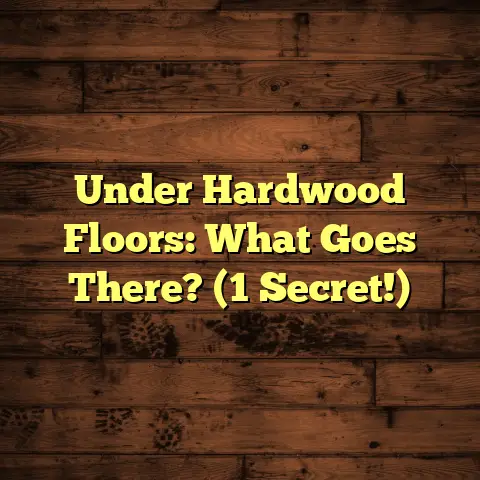Light Vs. Dark Hardwood Floors: What’s In For 2023? (Explained)
When I think about the choices homeowners face regarding flooring, I often imagine a couple standing in their newly built home, gazing at the empty space where memories will soon take shape. They’re pondering the age-old question: light or dark hardwood floors? As a flooring contractor with years of experience, I’ve seen firsthand how these decisions play out in real life.
Let’s explore what’s trending in 2023, sharing my insights and personal stories along the way.
The Light Hardwood Trend
Light hardwood floors have been gaining popularity over the last few years. Their ability to reflect light makes spaces feel larger and airier. I recall a project in a cozy apartment in the heart of Dhaka. The owners wanted a bright, welcoming vibe, so we installed maple flooring.
Installation Details:
- Material: Maple hardwood
- Area: 800 square feet
- Cost: Approximately $6,000, including labor and materials
- Timeframe: 3 days
The transformation was impressive. The light hardwood not only opened up the space but also complemented the white walls and natural light streaming through large windows. However, it’s worth mentioning that light floors can show dirt and scratches more easily than darker options. During the first month, the homeowners found themselves sweeping more often than anticipated.
Maintenance Tips for Light Hardwood
- Regular Sweeping: Dust and dirt can be more visible, so regular sweeping is key.
- Use Area Rugs: They not only add style but also protect high-traffic zones.
- Avoid Harsh Cleaners: Stick to products specifically designed for hardwood to avoid damage.
The Dark Hardwood Appeal
On the flip side, dark hardwood floors offer a sophisticated and warm look that many homeowners crave. I recently worked on a project for a family in Chittagong who opted for walnut flooring.
Installation Details:
- Material: Walnut hardwood
- Area: 1,200 square feet
- Cost: Around $9,000, including labor and materials
- Timeframe: 4 days
The rich tones of walnut created a stunning contrast against their light-colored furniture. However, one challenge we faced was ensuring the finish was perfect. Dark woods tend to highlight imperfections, so we took extra care during installation.
Maintenance Tips for Dark Hardwood
- Frequent Dusting: Dark floors can show dust and pet hair easily.
- Use Furniture Pads: These prevent scratches and dents from furniture.
- Consider Matte Finishes: They can help minimize the appearance of scuffs.
Balancing Aesthetics and Practicality
Choosing between light and dark hardwood isn’t just about aesthetics; it’s also about how each option fits into your lifestyle. For instance, if you have pets or young children, you might lean toward dark floors that camouflage wear and tear better than their lighter counterparts.
I’ve had clients express concerns about fading with dark floors due to sunlight exposure. In a recent job in Sylhet, we installed oak flooring with a UV-resistant finish. This added longevity to their investment while maintaining that deep color they loved.
Cost Considerations and FloorTally Insights
Cost is always a major factor in any flooring project. Using tools like FloorTally has made my life significantly easier when estimating costs for clients. For example, when working on that walnut installation in Chittagong, FloorTally helped me break down all expenses:
- Material Costs: Accurate local pricing for walnut.
- Labor Rates: Adjusted based on regional averages.
- Waste Factor: Incorporated to avoid unexpected expenses.
This platform allowed me to provide my clients with transparent and realistic estimates upfront—no hidden fees or surprises later on.
Design Trends for 2023
In 2023, I’ve noticed some interesting trends shaping the choice between light and dark hardwood:
- Mixing Tones: Some homeowners are opting for a combination of both. For instance, using light floors in living areas while choosing dark for bedrooms adds depth to spaces. This approach has become increasingly popular as it allows homeowners to enjoy the benefits of both styles.
- Textured Finishes: Hand-scraped or wire-brushed finishes are popular as they add character to both light and dark options. These finishes not only enhance the visual appeal but also help hide imperfections that may develop over time.
- Wide Planks: Wider boards create a more modern look, regardless of color. Many clients have shared with me how wide planks make their spaces feel more expansive.
Personal Anecdotes
I remember one project where a couple couldn’t decide between light and dark hardwood. They finally chose light oak but added dark walnut accents in their kitchen island. This mix not only helped them capture the essence of both colors but also showcased their unique style.
Another memorable job involved a client who loved the sleek look of dark flooring but was adamant about having a child-friendly home. Together, we settled on a high-quality engineered wood option that gave them the look they wanted without sacrificing durability.
Practical Advice for Choosing Your Floor
- Assess Your Space: Consider the size and natural light in your home. Smaller spaces benefit from light floors, while larger rooms can handle darker hues.
- Think About Lifestyle: If you lead a busy life with pets or kids, think about how your choice will hold up over time.
- Sample Testing: Always test samples in your home environment before making a final decision. How does it look with your existing furniture? How does the lighting affect it?
- Consult Professionals: Don’t hesitate to reach out to a contractor who can offer personalized advice based on experience.
Emotional Connection to Flooring Choices
Flooring is more than just a functional aspect of a home; it carries emotional weight as well. I once had a client who chose light birch flooring because it reminded her of her childhood home filled with sunlight. Each time she walked into her living room, she was transported back to those joyful memories.
Conversely, another family opted for dark mahogany because it echoed the elegance of their favorite restaurant where they celebrated special occasions. These emotional connections often guide homeowners in making their flooring selections.
Environmental Considerations
In recent years, sustainability has become an essential factor in flooring choices. Many clients are now looking for eco-friendly options that don’t compromise style or quality. Light woods like bamboo have gained traction due to their rapid growth cycle and sustainability.
On the other hand, darker woods like walnut can come from responsibly managed forests if sourced correctly. When discussing options with clients, I always emphasize checking for certifications like FSC (Forest Stewardship Council) to ensure their choices are environmentally friendly.
Color Psychology
The color of your flooring can significantly influence the mood and ambiance of your home. Light colors tend to evoke feelings of calmness and serenity, making them ideal for bedrooms or meditation spaces. They create an open and airy atmosphere that can help reduce stress.
In contrast, dark hardwood floors can instill warmth and coziness, perfect for gathering spaces like living rooms or dens where families come together to relax or entertain guests. They often create a sense of intimacy that lighter options may lack.
Understanding these psychological effects can help homeowners make more informed choices that align with their desired living environment.
Future Resale Value
When considering flooring, it’s essential to think about how your choices will impact your home’s resale value. Generally speaking, neutral tones tend to appeal to a broader audience.
Light hardwood floors often attract buyers looking for modern designs that feel spacious and bright. In contrast, dark hardwood may appeal to those seeking elegance and sophistication.
In my experience working with various clients, I’ve seen that homes with well-maintained hardwood floors—regardless of color—tend to sell quicker than those with other types of flooring.
The Installation Process
Understanding what goes into the installation process can demystify it for homeowners contemplating either option. Here’s a brief overview:
- Preparation: This involves removing old flooring and ensuring the subfloor is level.
- Acclimation: Both light and dark hardwood must acclimate to your home’s humidity levels before installation.
- Laying Down the Boards: Depending on the layout chosen (straight, diagonal), this step may vary in complexity.
- Finishing Touches: Once installed, applying a finish protects the wood and enhances its natural beauty.
The entire process can take anywhere from a few days to over a week depending on the size of the area and intricacies involved.
Common Challenges and Solutions
In my years as a contractor, I’ve encountered various challenges with both light and dark hardwood installations:
Light Hardwood Challenges:
- Scratches and Dents: Lighter woods are more susceptible to showing wear and tear.
- Solution: Use furniture pads to prevent scratches from heavy items.
- Water Marks: Light woods can develop water stains if spills aren’t addressed quickly.
- Solution: Encourage homeowners to clean spills immediately with gentle cleaning solutions.
Dark Hardwood Challenges:
- Fading from Sunlight: Dark woods can fade over time if exposed to direct sunlight.
- Solution: Recommend UV-protective window films or blinds to mitigate sunlight exposure.
- Visible Dust: Dust shows up more prominently on darker surfaces.
- Solution: Implement a regular cleaning schedule that includes dusting with microfiber cloths.
By addressing these challenges proactively with clients, I aim to provide them with practical solutions that enhance their overall satisfaction with their flooring choice.
The Role of Technology in Flooring Selection
Technology has played an increasingly significant role in helping homeowners make informed decisions about flooring choices. From virtual design tools to augmented reality apps that allow you to visualize how different options might look in your space—these advancements have transformed the decision-making process.
I’ve seen clients use apps that let them overlay various flooring types onto pictures of their homes before we even begin installation. It’s incredible how technology helps facilitate more confident choices.
Comparative Analysis: Light vs Dark Hardwood
To summarize our discussion thus far, here’s a comparative analysis of light versus dark hardwood flooring:
Aesthetic Appeal
- Light Hardwood: Brightens rooms; evokes openness; ideal for modern décor.
- Dark Hardwood: Adds warmth; creates elegance; perfect for traditional styles.
Maintenance
- Light Hardwood: Requires frequent cleaning; more visible scratches.
- Dark Hardwood: Shows dust easily; may require careful maintenance to avoid visible imperfections.
Resale Value
- Both options can maintain value if well maintained; lighter tones may attract broader interest due to neutrality.
Environmental Impact
- Light woods like bamboo are often more sustainable; darker woods should be sourced responsibly for eco-friendliness.
Emotional Connection
- Light woods may evoke nostalgia; dark woods may resonate with elegance and sophistication.
Ultimately, each option has its pros and cons depending on personal preferences and lifestyle requirements.
Conclusion: Making Your Choice
As we move through 2023, both light and dark hardwood floors have their distinct advantages and challenges. It ultimately boils down to personal preference and the specific needs of your home.
Whether you opt for the airy feel of light wood or the warmth of dark tones, each choice brings its own charm and character to your space. Reflecting on my experiences, I always encourage homeowners to choose what resonates with them and fits their lifestyle best.
So, which side are you leaning toward? Light or dark? Let’s discuss!





